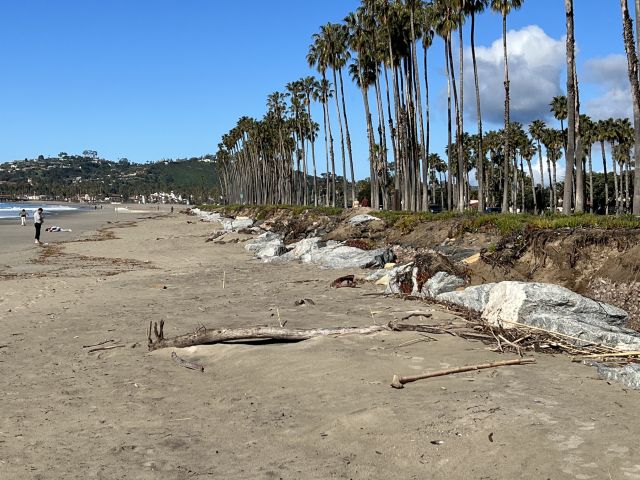UCSB SAND Lab begins statewide assessment to improve beach resilience to climate change impacts
New research project aims to identify sites, methods and actions needed to restore beach-dunes along California's coast.
By: Dr. Tim Baxter

Echoing the impacts of last year’s storm season, recent king tides, high surf, and storm surges during the holiday break yet again brought extensive flooding and erosion to California’s shores. While powerful swells and surging flood waters may delight surfers and curious onlookers, they also pose serious hazards and risks to coastal infrastructure, communities, and vulnerable ecosystems. Concern remains heightened this year due to a persistent El Nino phase, which is known to elevate coastal waters and correspond with enhanced flooding and erosion.
Coastal erosion and flooding are expected to increase along California’s shores as sea levels rise and storm regimes intensify with climate change. A recent study by the USGS suggests that between 25 and 70 percent of California's beaches could disappear by 2100 with plausible sea level rise scenarios of 0.5 to 3.0 m, respectively. Many of these beaches are backed by steep bluffs or critical infrastructure that challenges their ability to migrate landward as they would naturally. Others host protective dune systems that provide a natural buffer against flooding and erosion, which could provide a ‘nature-based solution’ to help mitigate the impacts of climate change and sea-level rise.
Recently, the state dedicated significant funding to improve California’s resilience to the impacts of climate change, including $100 million to the UC Office of the President to invest in collaborative research with actionable outcomes. Thirty eight Climate Action Fund Seed and Matching Grants were awarded to projects involving over 130 community, industry, tribal, and public agencies. Only two grants were awarded to UCSB, including a study led by Dr. Ian Walker (Geography) with co-PIs Jenny Dugan (Marine Science Institute) and Laura Engeman (UCSD/SIO) to study how coastal dune restoration could be used as a nature-based solution to enhance the resilience of California’s beaches to climate change.
The project builds on a network of over 20 collaborators and end users at 17 pilot sites across the state where dune restoration or re-introduction has been implemented for a variety of reasons using a broad range of methods, many of which are not informed by current science on sandy beach and dune ecology and geomorphology. There is also a general lack of common protocols and practices for restoring, monitoring, and reporting on sandy beach-dune ecosystems, which poses additional challenges for coastal resilience projects and community adaptation planning.
The main objectives of the project include:
1. Conducting a state-wide inventory and vulnerability assessment of coastal dunes in California to establish a comprehensive baseline of past and present attributes (e.g., dune types, extent, morphometrics, vegetation, critical habitats), ecosystem services, risks, and resilience potential.
2. Assessing beach and dune response and recovery to storm impacts and restoration efforts using modeling and existing observations at 17 pilot sites spanning the state to yield new information on, and understanding of, where and how various dune restoration methods can improve coastal resilience.
3. Developing a framework for evaluating site suitability and appropriate dune restoration methods to inform the eventual development of state-wide guidance and best-practice guidelines for beach and dune restoration as a nature-based solution to improve coastal resilience.
By addressing these key objectives, the project aims to identify sites, methods and actions to accelerate implementation and effectiveness of beach-dune restoration as a viable, scientifically informed, adaptation strategy for California’s coastal communities. The project is funded through 2025 and will seed additional grants, research, and training opportunities beyond.